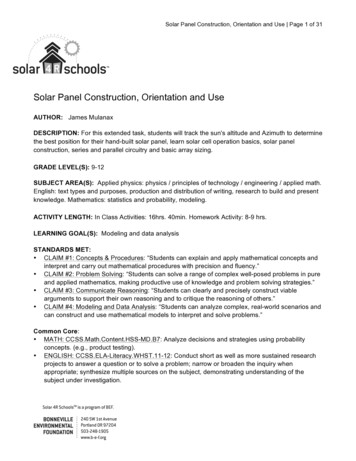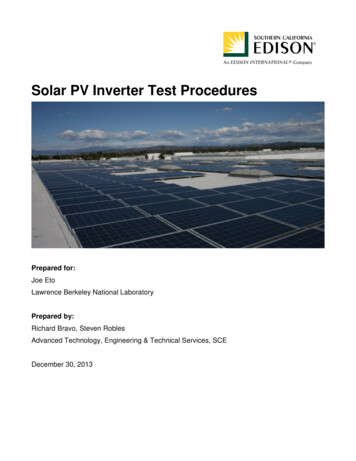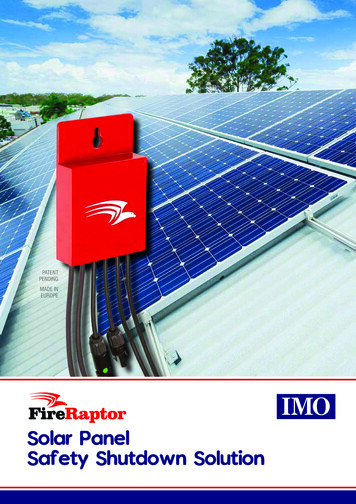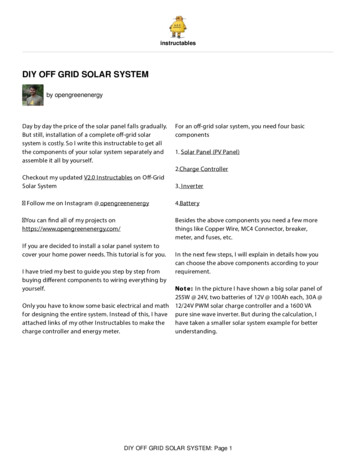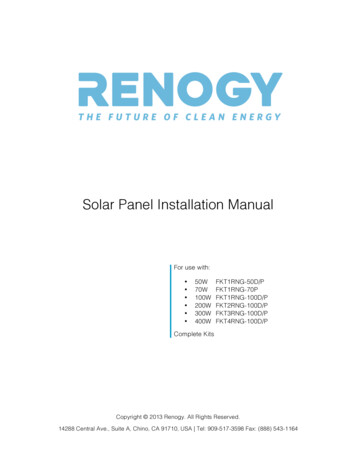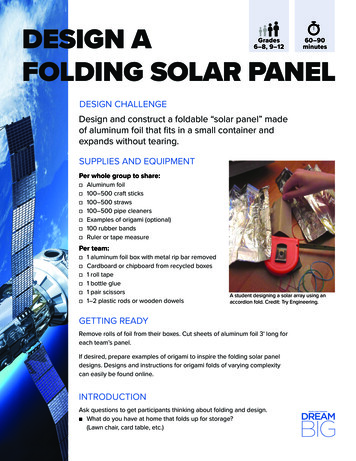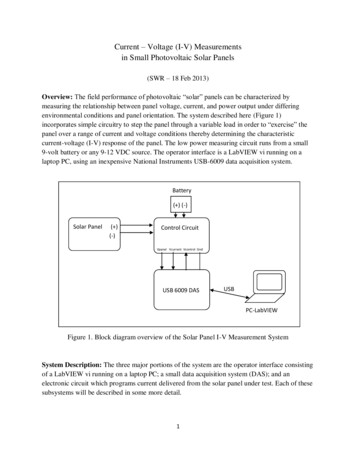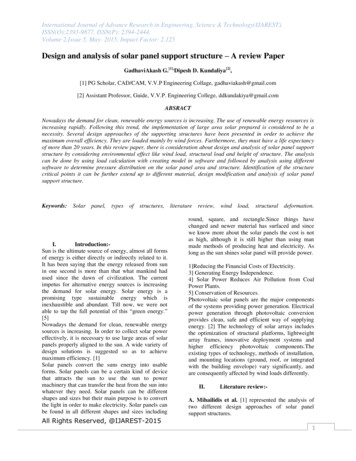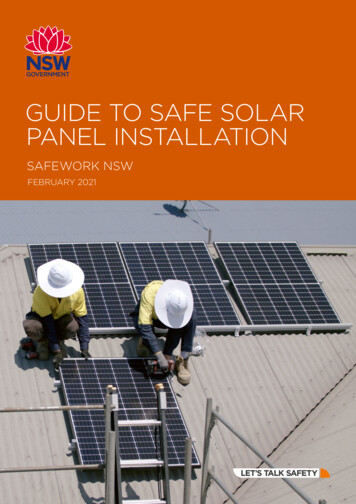
Transcription
GUIDE TO SAFE SOLARPANEL INSTALLATIONSAFEWORK NSWFEBRUARY 2021
DisclaimerThis publication may contain information about the regulation and enforcement of work health and safety legislation in NSW.It may include some of your obligations under some of the legislation that SafeWork NSW administers. To ensure you complywith your legal obligations you must refer to the appropriate legislation.Information on the latest laws can be checked by visiting the NSW legislation website www.legislation.nsw.gov.auThis publication does not represent a comprehensive statement of the law as it applies to particular problems or to individualsor as a substitute for legal advice. You should seek independent legal advice if you need assistance on the application of thelaw to your situation.This material may be displayed, printed and reproduced without amendment for personal, in-house or non-commercial use.Catalogue No. SW09388SafeWork NSW, 92–100 Donnison Street, Gosford, NSW 2250Locked Bag 2906, Lisarow, NSW 2252 Customer Experience 13 10 50Website www.safework.nsw.gov.au Copyright SafeWork NSW 0221
CONTENTS1.Introduction42. Requirements for businesses in the solar industry43. Planning for the installation54. Safe work method statements65. Hierarchy of control66. Safe installation of the solar pv system77. Site set-up88. Accessing the roof88.1Installing fall prevention118.2Fall prevention devices118.3Preventing falls through brittle/fragile roof material including skylights138.4Work positioning systems148.5Fall arrest systems149. Electrical risks1610. Other risks1710.1Working in ceiling voids1710.2 Handling1810.3 Asbestos1810.4 Information, training, instruction and supervision1911. Further informationAppendix 1: Example of the Solar installers safety checklist2021
1.INTRODUCTIONThis guide has been developed by SafeWork NSW to provide the solar industry clear direction oncontrolling risk. The guide should be read in conjunction with the Work Health and Safety Act 2011 &Work Health and Safety Regulation 2017 and relevant Codes of Practice.Installing solar photovoltaic systems (PV) exposes workers to risks of serious injury or death. Installersmust manage the risks to maintain a safe place of work.SafeWork NSW is the State’s work health and safety regulator. We promote compliance with workhealth and safety (WHS) legislation by providing information, education and assistance on WHSmatters to improve industry outcomes and ensure a fair and level playing field.2. REQUIREMENTS FOR BUSINESSES IN THESOLAR INDUSTRYThe solar installation industry includes system designers, manufacturers, solar retailers, installationcontractors and clients. Under the work health and safety legislation these are known as a personconducting a business or undertaking (PCBU). A person conducting solar installations may holdmultiple duty’s under the legislation, for example the solar retailer may also be the installer.System DesignersSolar photovoltaic (PV) system designers must consider the risks to worker health and safety for theinstallation and maintenance of the system. Where reasonably practicable systems should be installeda safe distance from fall and electrical hazards and allow for a safe means of access.System ManufacturersSolar PV system manufacturers must ensure that the system is manufactured to be without risk tohealth and safety of persons. For example, they must ensure adequate testing of the components, andthat adequate information is provided to those installing the system as well as the users of the system.Solar RetailersSolar retailers market and sell solar PV systems. This may include advice on the system that bestmeets the customer needs. Solar retailers may allocate installation work ‘in-house’ or subcontract thework to contractors. If the sale of solar panels includes installation, the business must have systemsin place to ensure the salesperson has sufficient knowledge to identify the safety controls that willbe required to be costed in the quotation and incorporated into the installer’s safe work methodstatement. Installation contractors must have sufficient knowledge, qualifications, equipment, skillsand procedures to comply with safety practices. Solar retailers must have an adequate system and siteaudit to confirm that installation contractors are undertaking work safely.Solar InstallersInstallation staff or contractors are involved in the direct installation of solar PV systems. Installersmust have sufficient knowledge, qualifications, equipment, skills and safe systems of work to complywith the work health and safety legislation. Installers must implement adequate supervision to ensurethat workers are undertaking work safely.Solar installation includes the installation of the solar components themselves, such as the panels andmounting rails. It also includes the installation of electrical equipment and wiring.4SAFEWORK NSW
3. PLANNING FOR THE INSTALLATIONYou must ensure that you have inspected the site prior to installation. This should be completed beforeproviding a quotation, which will ensure that the quote includes the cost of required safety controlmeasures such as temporary edge protection, scaffolding, EWPs, exclusion zones, access to the roofor mechanical lifting aids such as panel lifters.By inspecting the site, you can then develop a site-specific safe work method statement which is also alegal requirement.Some common hazards and risks are listed below: Working at heights:– access (both people and equipment)– falls from heights– falling objects– slippery glazed tiles or tiles with algae or moss deposits– roof pitch/slope– damaged roofing/fragile roofs/brittle roofing/skylights. Electrical:– discharge from uninstalled panels– electrical wiring, electrical fittings and electrical equipment– contact with overhead power lines or electrical cables, e.g. those located in the ceiling spaceunder the roof. Asbestos:– inhalation of asbestos fibres– fragile/brittle roofing. Weather conditions:– time of installation– wet, cold, icy, windy or hot days. Hazardous manual tasks:– handling/moving panels– handling solar panel mounting kits.If you work on solar installations: plan before accessing the roof use fall protection make sure all workers are trained assess and control electrical risks avoid live work use electrical equipment safely comply with relevant standardsGUIDE TO SAFE SOLAR PANEL INSTALLATION5
4. SAFE WORK METHOD STATEMENTSThe installation of solar PV systems requires businesses to undertake high-risk construction workas it usually involves the risk of a person falling more than 2 metres and work near live electricalinstallations. You must ensure that the safe work method statement (SWMS) prepared for high-riskconstruction work includes the specific hazards, risks and control measures for the site you areworking on. The SWMS should be developed in consultation with workers.When working out the suitable control measures, consideration must be given to the hierarchy ofcontrols. This ensures the highest level of protection is provided to protect the health and safety ofworkers and the public who may be affected by the work. You can access a sample SWMS templatefrom the SafeWork NSW website (www.safework.nsw.gov.au) by typing ‘safe work method statement’in the search bar.5. HIERARCHY OF CONTROLThe most important step in managing risksinvolves eliminating the hazard, or if that is notreasonably practicable, minimising the risks sofar as is reasonably practicable. When selectingcontrols you must consider various options andchoose a control that most effectively eliminatesthe hazard or minimise the risks. This may involvea single control measure or a combination ofdifferent controls put together to provide thehighest level of protection.The ways of controlling risks are ranked from thehighest level of protection and reliability to thelowest as shown in figure 1. This is known as thehierarchy of control and a business must workthrough this hierarchy when managing certainrisks, for example falls from heights, electricaland manual handling risks.Figure 1: Safety hierarchy of controlELIMINATIONRemove the hazard completely. Eliminating the hazard is the most effective way to manage risks.Where it is not practical to eliminate a hazard, risks must be minimised.Use one or more of the followingENGINEERINGChange the designSUBSTITUTE THE HAZARDReplace the hazard with something saferISOLATE THE HAZARDSeparate the hazard from peopleMinimise any remaining risk by using administrative controlsADMINISTRATIONHealth and safety procedures and policies e.g. - safe work procedures, staff trainingIf risks remain, the possible impact on people must be controlled using PPE.PERSONAL PROTECTIVE EQUIPMENT (PPE)e.g. - safety glasses, hard hats, protective clothingThis is the least effective way to manage risks6SAFEWORK NSWFigure 1: Safety hierarchy of control
6. SAFE INSTALLATION OF THE SOLAR PV SYSTEMWhen conducting solar installations there are specific requirements that must be complied with duringthe installation.The solar PV system installation must be carried out by a licenced electrician experienced in thespecific work.While installing the solar panels: use the identified control measures for eliminating or minimising the risk of falls from heights, andother hazards like asbestos follow the safe work procedures for installing the solar panels and supporting structures includingfollowing the manufacturer instructions ensure manufacturer requirements are followed when installing mounting points for the solar panelsframing, considering the highest wind speeds for the region (refer to AS/NZS1170.2:2002 Structuraldesign actions – Wind actions) ensure that external wiring is protected from UV rays ensure that mechanical protection of cables is provided in accordance with AS/NZS 3000Australian/New Zealand Wiring Rules and AS/NZS 3008.1.1:2017 Electrical installations – Selectionof cables ensure that risks associated with manual handling are controlled.It is the electrician’s responsibility to ensure a copy of the Certificate of Compliance – Electrical Work(CCEW) is provided: for any electrical work to the person (customer) for whom the work is carried out to the customer, distributor and Fair Trading for new electrical installations to the customer, distributor and Fair Trading for any alterations or additions to an existing electricalinstallation that will require additional work to be done in relation to the network connection for theinstallation to the customer, distributor and Fair Trading for work on a switchboard or associated equipment to the customer and Fair Trading for electrical installation work for an installation using astand-alone power system to the customer and Fair Trading for installation, alteration or replacement of an electricity meter.GUIDE TO SAFE SOLAR PANEL INSTALLATION7
7. SITE SET-UPAn essential step in the risk management process is to ensure that risks associated with the worksiteset-up are controlled for example:1. Define the work area2. Ensure materials delivery points area. reasonably level and suitable for unloading, andb. where using a vehicle loading crane or elevated work platform, loading areas should bei. reasonably level,ii. able to support the use of the plant, andiii. clear from overhead power and service lines.3. Establish an exclusion zone to prevent unauthorised persons from accessing the work area.A way of achieving this is by erecting barrier tape attached to bollards and signage.4. Work vehicles are parked in areas that minimise worker exposure to the risks of vehicular traffic.8. ACCESSING THE ROOFSafe access and egress to the roof must be established. You will need to consider the space available, theheight, the size and shape of the panels and how they will be lifted, and how many persons need access.For large installations, temporary scaffold stairways or a mobile scaffold are an efficient, cost-effectiveand safe option as a means of access. A competent person should install scaffold stairs in line withthe manufacturer specifications and, if the scaffold is over 4 meters in height, a person who holds ascaffolding high risk work licence must install the scaffold.Figure 2: Mobile scaffold with access ladder and trapdoor8SAFEWORK NSWImage 1: An example of scaffold stairs
Figure 3: Boom-type elevating work platformFigure 4: Scissor-lift elevating work platformAn elevating work platform (EWP) may also be a suitable means of access. When considering the useof an EWP as a means of access, you must ensure systems of work are in place to allow safe accessfrom the EWP basket onto the roof surface, for example: roof surface can bear the weight of a person(s), loads and material to be used workers are not exposed to unprotected roof edges or voids when exiting or entering the platform.The step height from the EWP basket onto the roof should be no greater than 300mm.For smaller works where temporary scaffolds or EWPs are not suitable, a mobile scaffold or ladder canbe considered. When using a ladder, it can only be used for access/egress to the roof, not for transferringequipment or material such as panels and mounting equipment onto the roof. You must ensure that: the ladder meets Australian standards and the load requirements of the job the ladder has been inspected for damage before each use any workers using the ladder are physically capable of doing so the ladder is always set up on a flat, stable surface. If this isn’t possible, then use a ladder thatincludes ladder safety devices like leg levellers, anti-slip gutter guards and stabilisers always maintain three points of contact when climbing or descending the ladder. This means twohands and one foot, or two feet and one hand the ladder extends 1 metre past the landing surface ladders must only be used for access/egress. The carrying of tools must be in a tool belt to enablethe worker to keep both hands free when climbing or descending users never lean or reach away from the ladder while using it the combined weight of the person using the ladder and any items or tools should never exceed theworking load limit on the ladder if you are using an extension ladder, ensure it is secured at the top, bottom or both. If this isn’tpossible, then have someone hold the ladder in place while in use extension ladders should be angled at a ratio of 1:4. That is, position the base of the ladder 1 metreaway from the structure for every 4 metres of height do not climb or work past the second-last rung of a ladder and never straddle the top of anA-frame ladder when climbing down, remain facing the ladder and climb to the bottom rung before stepping off.You should also consider installing a static line to minimise the risks of workers falling from the ladder.Further information: video safety alert concerning Ladders.GUIDE TO SAFE SOLAR PANEL INSTALLATION9
Figure 5: Example of acceptable ladder useFigure 6: Anchorage line system for ladder useFigure 7: Examples of unsafe ladder useImage 2: Base of ladder secured on lower level roof10SAFEWORK NSW
8.1INSTALLING FALL PREVENTIONBoth falls from the edge of a roof and through a roof, such as fragile or brittle materials or skylights,must be considered.Note: Skylights, or alsynate sheeting, are extremely hazardous falls risks for solar installers and haveresulted in death.Hierarchy of ControlFalls from roof edges must be controlled, and as a business you must ensure the hierarchy of controlis applied when managing the risks of falls so far as is reasonably practicable. This means in the firstinstance you must consider the highest level of protection to keep your workers safe before using alower order control. You can find further information on what reasonably practicable means on theSafeWork NSW website.Controlling the Controllingrisk of fallsthe risk of tbebeused.used.A fall prevention device such as a scaffold,temporaryprotectionor anpracticableelevating workplatformOnlywhere it isnot reasonablyA fallpreventiondevicesuch as aOnly whereedgeit is notreasonablyto usea fall (EWP).practicableto use a fallpreventionyou can then considerscaffold,a work positioningsystemsuch as atemporary edgeprotectionpreventiondeviceyou candevicethen consider total restraint system. If this is not reasonably practicable you canthenconsidera fallarrest systemor anelevatingworkplatform(EWP)such as static lines, adjustable restraint lines, catch nets a work positioning system and if this is not reasonablypracticable you can then consider a fall arrest systemA total restraint systemStatic lines, adjustable restraint lines,catch netsTable 1: Controlling the risk of falls hierarchy with examples of fall protections8.2 FALL PREVENTION DEVICESTemporary edge protection is reasonably practicable and the most effective means of preventing fallsfrom roof edges. This control can increase site productivity whilst also reducing risk to your workers,as opposed to using a harness.Consideration should be given to edge protection systems installed from the ground where practicable.Where edge protection is used it should comply with AS/NZS 4994.1:2009 Temporary edge protection– General requirements and should be erected in accordance with AS/NZS 4994.2:2009 Temporaryedge protection – Roof edge protection – Installation and dismantling.Where scaffold is used it should comply with AS/NZS 1576 Scaffolding general requirements and ifthere is risk of persons or an object falling more than 4 metres, it must be erected by a person whoholds a scaffolding high risk work licence.GUIDE TO SAFE SOLAR PANEL INSTALLATION11
Images 3-6: Examples of temporary edge protectionEdge protection may be omitted (based on a risk assessment) only on roofs below 7-degree pitch wherea 3 metre exclusion zone can be maintained. The exclusion zone must be a minimum of 3 metres fromthe roof edge or void and be delineated with a barricade. Safe access must be provided to the exclusionzone, for example elevated work platform, mobile scaffold or delineated walkway with secure ladder.12SAFEWORK NSW
Image 7: Example of delineated exclusion zone8.3 PREVENTING FALLS THROUGH BRITTLE/FRAGILE ROOFMATERIAL INCLUDING SKYLIGHTSPrior to work commencing an assessment must be made by a competent person regarding the roofmaterial and whether the roof can bear the weight of persons, materials and equipment used as part ofthe solar installation. You must assume that the roof is fragile unless confirmed otherwise by thecompetent person.Consideration needs to be given to the following: the location of polycarbonate or plastic commonly used in skylights roof lights, particularly those in the roof plane that can be difficult to see in certain light conditionsor when hidden by paint fibre cement sheets alsynite or similar glass, including wired glass slate corroded fasteners rotted timbers significant deformation of the roof.If there is a risk of falling through a roof surface, additional protection must be provided. This may include: an elevating work platform so workers can avoid standing on the roof itself physical barriers such as guard rails covers that are secured and labelled with a warning, e.g. formply with a warning sign or fixedsteel mesh barricaded exclusion zones at least 3 meters from the void walkways or crawl boards of a suitable size and strength staging on the roof surface to spread the load(s) safety mesh (refer to AS/NZS 4389:2015 Roof safety mesh).GUIDE TO SAFE SOLAR PANEL INSTALLATION13
Images 8-10: Examples of physical barriers to manage risks of falling through skylights and brittle roof material.8.4 WORK POSITIONING SYSTEMSIf it is not reasonably practicable to provide physical edge protection, a work positioning (harness)system may be used. A work positioning system requires correct design and reliance on userbehaviour to ensure its effectiveness.Total restraint technique always physically prevents a fall hazard from being reached. The systemcannot be incorrectly adjusted, disconnected during use or have parts interchanged; for example,the user connects a device to a static line at the point of entry, the device cannot be removed fromthe static line until the user either reaches the endpoint or moves back to the entry point, the lanyardis a fixed length and cannot be adjusted.8.5 FALL ARREST SYSTEMSOnly if it is not reasonably practicable to provide physical edge protection or to use a work positioningsystem may a fall arrest system be considered.In most single storey residential homes the roof height will not provide enough clearance to the groundto enable a fall arrest system to activate appropriately and, therefore, a fall arrest system cannot besafely used.When using a fall arrest system, you must develop an emergency plan including rescue proceduresin relation to fall arrest. These procedures must be tested to ensure they are effective, and you mustprovide adequate information, training and instruction to workers in relation to the rescue procedures.Restraint technique uses a fall arrest system with an adjustable lanyard. The system design and setupmust prevent a user from reaching a fall hazard. The system usually requires multiple anchors tocover the working area and requires the user to install and connect to the anchors as they traversethe entire work area, keeping their lanyard adjusted to prevent them from reaching a fall hazard.These systems rely heavily on worker behaviour to ensure effectiveness and often fail due to incorrectsetup or application.When implementing a restraint technique, the system of work should include the following:A documented plan which shows: the system layout access points including method, i.e. scaffold stairs, ladder all fall hazards such as edges, skylights, polycarbonate roof sheets anchor point locations and the number of anchors required the radius of travel from the anchor in relation to the fall hazards.14SAFEWORK NSW
Documented equipment registers which show: equipment type, serial number, date of last inspection and date of withdrawal evidence that the equipment being used is rated for fall arrest the type and length of lanyard being used that is attached to rope grab and rear dorsal of the harness anchor types, the fall arrest rating per anchor and the number of screws and type required tosecure the anchor to the roof in accordance with manufacturers specifications.A business must be able to demonstrate this information when a SafeWork NSW Inspector attends the site.This information will assist with determining compliance in relation to the work positioning system beingused. Workers must be provided information training and instruction in relation to the use of these systems.Figure 8: Example of an anchor planGUIDE TO SAFE SOLAR PANEL INSTALLATION15
9. ELECTRICAL RISKSThe installation of solar PV systems exposes workers to serious risks of electric shock or electrocution.It is important to ensure electrical work is conducted by someone holding an electrical contractorlicence, or an electrical qualified supervisor certificate or under the supervision of a person who holdsan electrical qualified supervisor certificate issued by NSW Fair Trading. Further information can befound by visiting the NSW Fair Trading website.Before starting any solar installation work, you must ensure that you turn off and isolate all electricitybeing supplied to the property at the main switch board. You should also take steps to prevent theelectricity from being turned back on while work is in progress, known as lock-out/tag-out (LOTO).Once electricity is isolated you must determine that the electrical equipment is de-energised, alsoknown as testing for dead. By switching off the power at the meter box, the electricity supply from thestreet to the meter box will remain live. This includes overhead service lines and the consumer mainsfrom the point of connection to the property into the switch board. Steps must be in place to preventworkers from coming in contact with these services.Before entering any ceiling space: identify and confirm all sources of electricity to the property. There may be more than one sourceor multiple properties powered from the same meter box identify any hazards that may be introduced as a result of isolating the power to the affectedproperty switch OFF all power at the electricity meter box and place a lock on the MAIN SWITCH or on themeter box itself. This will prevent inadvertent re-energisation. If it is not reasonably practicable touse a lock, use a recognisable lock-out tag for workers entering the ceiling space, always “test for ‘dead’ before you touch” – beforeundertaking any electrical work.When using electrical equipment, ensure that: workers are trained in its safe operation as per the manufacturer instructions workers are provided with the appropriate personal protective equipment (PPE) such aseye protectors/face shields and safety footwear.Consideration should be given to the use ofcordless power tools during the install. Ensure allportable electrical equipment is: inspected, tested and maintained regularly used in conjunction with a 30mA ResidualCurrent Device (RCD or safety switch) visually inspected for damage before use not located in wet places not dragged over sharp edges onmetal sheeting.Image 11: Example of main electrical switch with lock16SAFEWORK NSW
Image 12: Testing before you touchImage 13: Testing for dead10. OTHER RISKS10.1 WORKING IN CEILING VOIDSWhen workers are required to access the ceiling voids, consideration needs to be given regarding therisks associated with this space. For example: heat stress electric shock electrocution falling through the ceiling inhalation of roof insulation fibers.The following controls can be implemented to manage the risks:To avoid electrocution: switch off the electricity supply to the whole area before you touch, move or physically disturb anyelectrical wiring, cable or junction box connection always seek the services of a competent, such as an electrician only attempt electrical work or tasks where you have the required skills or qualifications.To avoid heat-related illness: determine entry time – for example, early morning or by assessing the temperature before enteringthe space ensure sufficient cool drinking water is available to ensure workers remain hydrated ensure all workers are trained in heat-risk awareness and how to recognise heat stress symptoms inthemselves and their workmates.Other safety considerations include: using crawl boards to walk across the ceiling space ensuring your entry and exit points are easily accessible stabilising and securing ladders to avoid slipping when being used using appropriate personal protective equipment (PPE).GUIDE TO SAFE SOLAR PANEL INSTALLATION17
10.2 HANDLINGThe handling of solar panels and the components that form the solarPV system is a hazardous manual task, as the task can expose workersto a musculoskeletal disorder.The handling of solar panels and associated installation materialscan also create falls risks where handling processes are insufficient.The carrying of panels by workers up ladders is not a safe system ofwork and must not be conducted.To minimise the risks of workers sustaining a musculoskeletal disorder,consideration should be given to the hierarchy of control for example: using a panel lifter using a mobile crane using a scissor lift using a winch and davit arm from a scaffold.10.3 ASBESTOSImage 14: Example of a panel lifterUNDER NO CIRCUMSTANCE CAN HIGH PRESSURE WATER SPRAY OR COMPRESSED AIR BEUSED ON ASBESTOS CONTAINING MATERIALAsbestos containing material may be located in a number of work locations where solar installationsmay occur, this includes: roof and wall sheeting, ridges, barge capping, gutters, eaves and downpipes electrical backing boards and some fuses and conduits in switchboards ceiling spaces (insulation, pipe lagging, delamination of roof).It is recommended that asbestos containing material that is likely to be disturbed be removed andreplaced with non-asbestos materials prior to installation of the solar system.Asbestos containing roof sheets can be brittle, slippery and in poor condition.The use of power tools or any equipment that causes the release of airborne asbestos into theatmosphere is not permitted unless the equipment is controlled.The installation of solar panels requires the fixing of multiple screws that require drilling through thecorrugated asbestos sheeting. The use of power tools or other equipment can cause breakage andcontaminate the ceiling space.The use of local exhaust ventilation or shadow vacuuming with a low speed drill and H Class HEPAvacuum may not be reasonably practicable. The roof sheeting is corrugated and local exhaustventilation may not be effective. Shadow vacuuming may not capture dust and debris falling into theceiling space.Persons undertaking work with asbestos must have the following: asbestos awareness training (minimum) that includes identification, safe handling and suitablecontrol measures in particular to the installation of solar panels and with asbestos containingbacking electrical boards asbestos PPE (minimum half-face P2 respirators, disposable type 5 category 3 coveralls, gloves andappropriate footwear that prevents slips (double bagged after use for any future asbestos use) appropriate tools and equipment (low speed drill fitted with local exhaust ventilation, Class H HEPAvacuum, 200micron plastic bags and drop sheets)18SAFEWORK NSW
health monitoring for all workers who carry out ongoing asbestos-related work safe work method statement which includes all high-risk activities involved (asbestos, heights, gas,electrical, confined spaces, mobile plant).Any removal of over 10 sq met
ensure that mechanical protection of cables is provided in accordance with AS/NZS 3000 Australian/New Zealand Wiring Rules and AS/NZS 3008.1.1:2017 Electrical installations – Selection of cables ensure t



